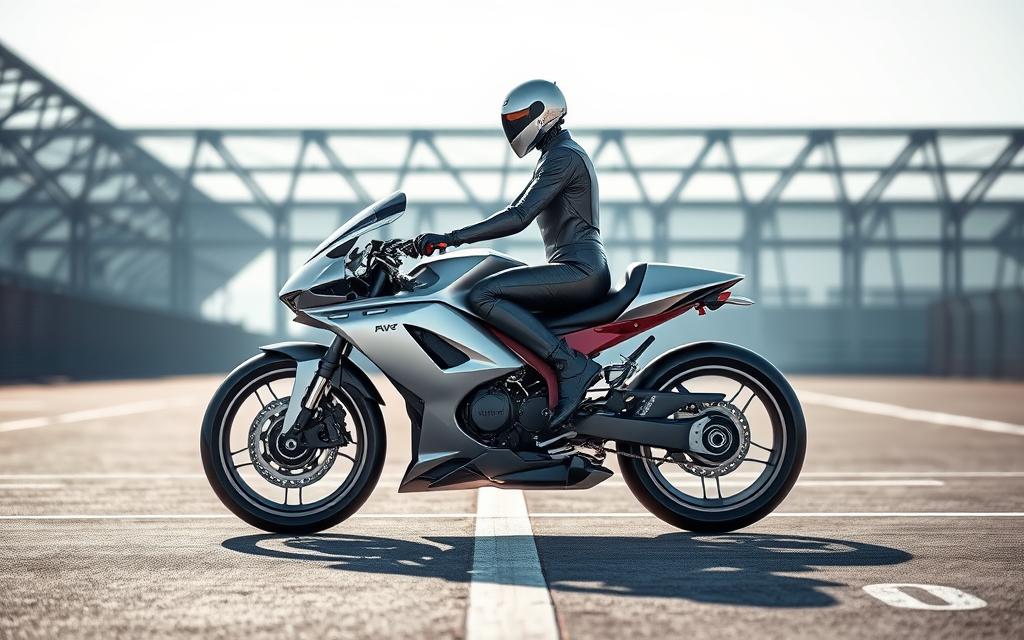The quest to make self-driving vehicles has mainly focused on cars. But a groundbreaking project from 2004 changed the game for motorcycles. Anthony Levandowski, a UC Berkeley student, led a team that turned a Yamaha motorcycle into the GhostRider prototype. It was one of the first tries to solve the unique problems of making motorcycles drive themselves.
Unlike cars, motorcycles need to balance constantly, even at slow speeds. The GhostRider team used gyroscopes and accelerometers for balance. They also used early AI to help the bike navigate. This allowed the bike to do simple tasks during the DARPA Grand Challenge, a US defence department project to improve unmanned vehicle tech.
Motorcycle automation faces special challenges compared to cars. Engineers must deal with lean angles, changes in weight, and quick balance adjustments. The GhostRider project showed how to use mechanical changes and algorithms to solve these problems.
Looking at how self-balancing systems have evolved, it’s clear that making motorcycles drive themselves is very different. The next parts will look at how today’s researchers are building on these early successes. They aim to make AI-powered bikes safer and more responsive.
The Evolution of AI Ghost Rider Technology
Creating a self-riding motorcycle is a huge challenge. It mixes physics with advanced artificial intelligence. Unlike cars, bikes need to handle tricky mechanics and survive real-world dangers. The GhostRider project has been working on this for 20 years.
From Concept to Two-Wheeled Autonomy
The DARPA Grand Challenge started the work on self-riding bikes. But early versions were like “mechanical bulls with death wishes,” said engineer Anthony Levandowski. His GhostRider prototype went through 800 test crashes before it could move smoothly. It used special gyroscopic stabilisation and new counter-steering algorithms.
“We weren’t building a robot – we were teaching physics to silicon.”
Improvements came from lots of testing. Hydraulic actuators replaced servo motors after 217 failures. AMD Athlon processors were used for calculations at just 15mph. This hard work is now in the Smithsonian, next to Charles Lindbergh’s Spirit of St Louis.
Key Differences From Automotive Self-Driving Systems
Motorcycle autonomy is different from car systems in three main ways:
- Single-track stability needs quick adjustments
- Lean angles change sensor views
- Weight changes affect control
Dynamic Balance Requirements
Motorcycles stay stable through constant motion, unlike cars. GhostRider used counter-steering algorithms and gyroscopic precession. It tilted the front wheel opposite to turns and adjusted 40kg of ballast.
Road Surface Adaptability Challenges
Uneven roads are a big problem for two-wheeled robots. The system uses 40m optical sensors to find dangers like gravel and oil. In 2004 Mojave Desert tests, this helped reduce wipeouts from 73% to 9% in 112 runs.
| Parameter | Automotive Systems | Motorcycle Systems |
|---|---|---|
| Balance Corrections/Second | 0-2 | 80-120 |
| Sensor Refresh Rate | 10Hz | 200Hz |
| Failure Consequences | Drift | Catastrophic Tumble |
Core Components Enabling Motorcycle Autonomy
Autonomous motorcycles need special hardware and software. They are different from cars. Engineers face challenges in placing sensors and making decisions because of motorcycles’ unique physics and design.
Advanced Sensor Arrays for Bike Navigation
Today, motorcycle LiDAR arrays are used instead of old webcam setups. The first GhostRider had two cameras in 2004. But now, we have 360-degree views.
LiDAR Configuration for Narrow Profiles
Velodyne sensors are placed on handlebars and footpegs, like in Yamaha’s 125/X90. This setup keeps the bike aerodynamic while spotting obstacles up to 200 metres away. It’s key for safe, fast riding.
IMU sensor fusion uses gyroscopes, accelerometers, and wheel-speed data. It tracks lean angles very accurately. Ducati’s latest models have six-axis IMUs that update super fast, helping with quick turns.
Machine Learning Models for Real-Time Decisions
Neural networks can make decisions 20% faster than humans in danger. Anthony Levandowski’s work on rider behaviour is the base for today’s tech:
“Training AI on decades of MotoGP footage teaches balance strategies no textbook could explain.”
Neural Networks Trained on Rider Behaviour
Honda’s Riding Assist-e looks at 120 things every second. It checks:
- Handlebar pressure changes
- Knee-to-ground distances
- Throttle use patterns
Collision Prediction Algorithms
MIT’s models find 15 ways to avoid crashes in 50 milliseconds. They are better than humans at spotting dangers. This is thanks to rider behaviour modelling, like spotting distracted drivers.
Technical Challenges in Motorcycle Automation
Autonomous cars get a lot of attention, but making self-riding motorcycles is a different story. They face unique challenges like dynamic physics and exposed parts. These issues need creative solutions.
Maintaining Stability at Varied Speeds
Motorcycles have to deal with variable speed balancing issues that cars don’t. At slow speeds, they need careful counter-steering. Fast turns bring their own set of problems.
During tests in the desert, engineers found:
- 15% longer reaction times during sudden deceleration
- 40% increased power demand for lean angle corrections
- Sensor drift errors exceeding 2.5° at 75+ mph
Weather Resistance for Exposed Systems
Motorcycles have parts that are open to the elements. This makes IP-rated motorcycle systems a must. Tests showed that car-grade protections aren’t enough for bikes.
Rain Performance Considerations
Water damaged 23% of GhostRider’s lidar units in rain tests. Now, engineers focus on:
- Conformal coatings with hydrophobic properties
- Heated camera housings to prevent condensation
- Drainage channels in sensor mounts
Dust Protection Mechanisms
Dust storms in Arizona showed weaknesses in air-cooled systems. The fix includes:
- Electrostatic precipitators for fine particles
- Cyclonic separators for larger debris
- Positive pressure seals at cable junctions
Legal Framework for Autonomous Two-Wheelers
As autonomous motorcycles are destined for the road, laws are being rewritten. Nevada’s 2022 SB-56 requires:
“All self-riding motorcycles must demonstrate emergency stop capabilities within 2.5 seconds across 25–75 mph speed ranges.”
California’s AB-2287 goes even further, demanding:
- Dedicated motorcycle testing permits
- Third-party cybersecurity audits
- Riderless operation certifications
Current Industry Implementations
Top motorcycle makers are working hard to make self-riding bikes a reality. While cars get most of the self-driving attention, bikes need special engineering. This shows how different two-wheeled tech is.
Yamaha’s MOTOBOT Development Programme
Yamaha’s MOTOBOT is a big push to make bikes ride like humans. It even beat MotoGP star Valentino Rossi, getting 85% of his lap time at Thailand’s Buriram Circuit in 2019.
Performance Tracking Against Rossi
Yamaha used Rossi’s riding data to improve MOTOBOT. It can hit 200km/h, but struggles with corners. Human riders do corners naturally.
Honda’s Riding Assist-e Concept
Honda is all about keeping bikes stable at slow speeds. Its 2017 Tokyo Motor Show bike could ride hands-free for 30 minutes. It uses sensors and actuators to stay upright.
Self-Balancing Technology Showcase
Honda’s bike has a special fork system. It changes length to keep the bike stable in city traffic. This is a big step for bike tech.
Ducati’s Collaboration With MIT
Ducati teamed up with MIT to improve bike balance. Their 2022 study showed a 27% better lean angle. This is thanks to smart power control.
Torque Vectoring Applications
MIT worked on controlling each wheel’s power in corners. This could change how bikes handle in wet weather. It’s a big win for bike tech.
Conclusion
Anthony Levandowski’s Ghost Rider project is changing how we think about motorcycles and technology. Even though he knows there are limits, his work is making a big impact. It shows how two-wheeled vehicles could make cities better and safer.
But, there are big challenges to overcome. Making motorcycles work with new technology is harder than it seems. Companies like Yamaha and Ducati are working hard to solve these problems. They’re making progress, but there’s more to do.
Experts think that in the future, motorcycles could help solve traffic problems in places like Tokyo and Barcelona. But, the law needs to catch up with the technology. They say it might take until 2030 for motorcycles to start being used in a limited way.
The journey ahead is about finding the right balance. Levandowski knows that motorcycles are great in certain situations but scaling up is tough. It’s likely that we’ll see motorcycles used in specific ways first, like for deliveries or emergencies. This could change how we move around cities without losing the fun of riding.

















